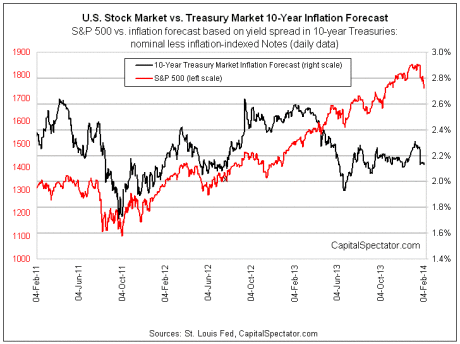The tumble in stock prices lately has been accompanied by a so-far mild retreat in inflation expectations (the spread on the nominal 10-year Treasury yield less its inflation-indexed counterpart). This relationship deserves close attention… again. A weak stock market is one thing. But if the market’s outlook for inflation slides further, that’s another matter entirely and one that comes with bearish implications for the economy if it unfolds with dramatically lower stock prices.
Recall that until roughly a year ago inflation expectations and stocks had been tightly connected. Equities tended to rise (fall) as inflation expectations increased (decreased), a relationship that I call the new abnormal. Abnormal because higher inflation in the grand historical scheme of macro and markets isn’t usually a bullish scenario for stocks. But after the financial crisis in 2008, the relationship changed, thanks to the higher risk of disinflation/deflation. Accordingly, expectations of higher (lower) inflation was considered bullish (bearish).
But the new abnormal seemed to give way in early 2013 as the economy developed a deeper level of forward momentum. Last April, I asked the question: “Has the stock market finally broken free of inflation expectations?” A year on, we now know that the answer has been “yes” for much of the past 12 months, and the decoupling has been a healthy change. A stock market that rises and falls because of changing expectations with corporate earnings and economic fundamentals vs. the outlook for inflation is a return to something approximating a normal state of affairs. But with a dose of wobbly economic news in the US and elsewhere in the world in recent weeks, it’s reasonable to wonder if the new abnormal is mounting a comeback.
It’s premature to say anything definitive at this point. Indeed, inflation expectations are still in the low-2% range that’s prevailed since last July. Meantime, stocks will continue to fluctuate and it’s best not to read too much into short-term price volatility. Nonetheless, inflation expectations are again on my short list of indicators to monitor.
The bottom line: If the market’s estimate for inflation via 10-year Treasuries falls below 2% at some point that would be a worrisome sign—particularly if it’s tied with sharply lower stock prices. For the moment, the risk of a) lower prices and 2) lower inflation projections still looks like a low-probability event, in large part because the broad trend for a diversified set of economic and financial indicators still looks encouraging (see last month’s US Economic Profile).
But more recent economic news suggests a bit of turbulence is brewing in the economic trend. It may be noise… or not, and so it’s important to keep a close eye on the incoming data and adjust the analysis accordingly. That includes watching Mr. Market’s shifting estimates for inflation.

Pingback: Is the New Abnormal Threatening a Comeback? – The Capital Spectator | Marty Investor
Pingback: Wednesday links: after-tax returns | Abnormal Returns
Pingback: Hot Links: Good Not Great | The Reformed Broker
Pingback: A Bullish Disconnect Between Stocks & Inflation
Pingback: A Bullish Disconnect Between Stocks And Inflation | Prompto Capital